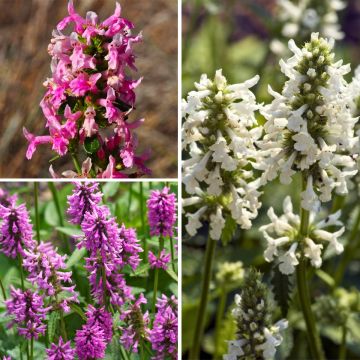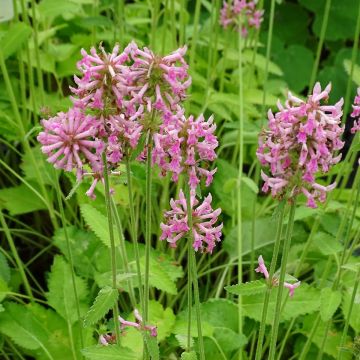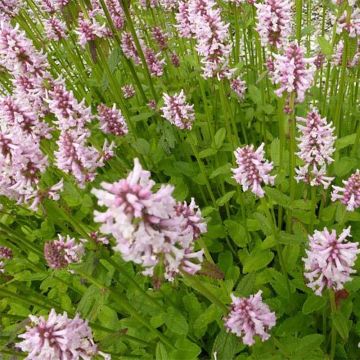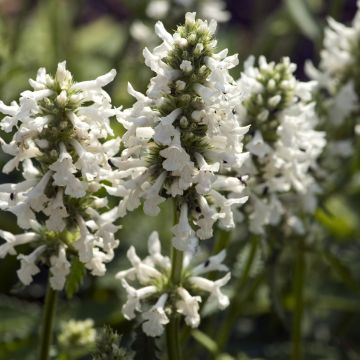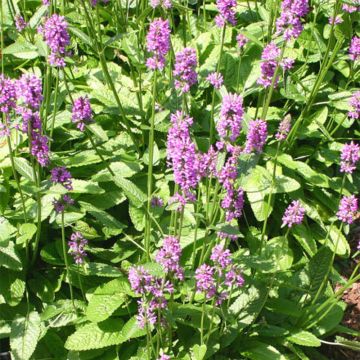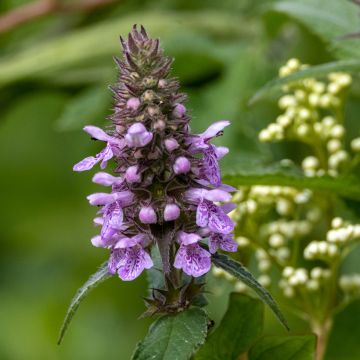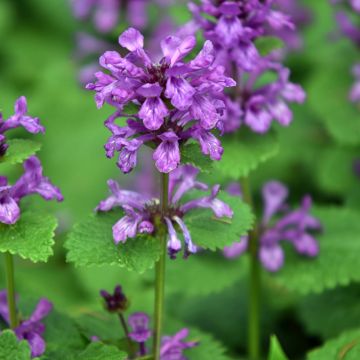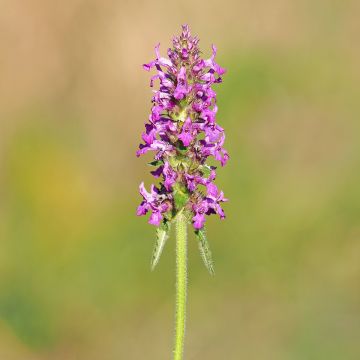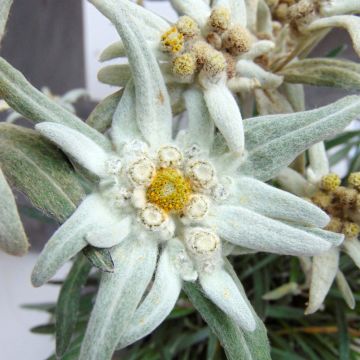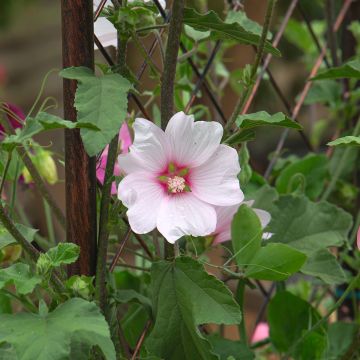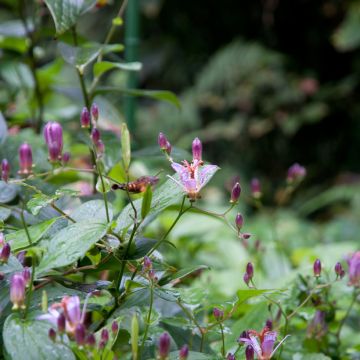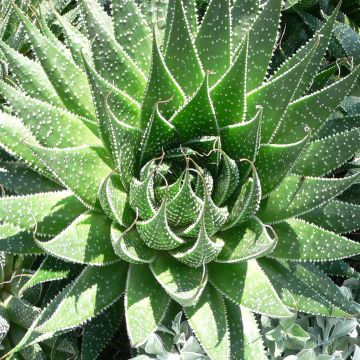

Stachys byzantina Big Ears


Stachys byzantina Big Ears


Stachys byzantina Big Ears


Stachys byzantina Big Ears


Stachys byzantina Big Ears


Stachys byzantina Big Ears
Stachys byzantina Big Ears
Stachys byzantina Big Ears
Lamb's Ear, Bear's Ear, Wooly Betony, Bunnies' Ears, Mouse Ear, Rabbit Ear, Woolly Woundwort, Cat's Ear, Lamb's Tongue, Lamb's Wool
The plant has much smaller leaves than I expected (barely 5cm) and has bloomed much pinker than in the photo. It makes me wonder if it's really the Big Ears variety that I received. However, I'll give it the benefit of the doubt, hoping that it will prove itself more next year!
véronique, 07/11/2024
Special offer!
Receive a €20 voucher for any order over €90 (excluding delivery costs, credit notes, and plastic-free options)!
1- Add your favorite plants to your cart.
2- Once you have reached €90, confirm your order (you can even choose the delivery date!).
3- As soon as your order is shipped, you will receive an email containing your voucher code, valid for 3 months (90 days).
Your voucher is unique and can only be used once, for any order with a minimum value of €20, excluding delivery costs.
Can be combined with other current offers, non-divisible and non-refundable.
Home or relay delivery (depending on size and destination)
Schedule delivery date,
and select date in basket
This plant carries a 12 months recovery warranty
More information
We guarantee the quality of our plants for a full growing cycle, and will replace at our expense any plant that fails to recover under normal climatic and planting conditions.

Would this plant suit my garden?
Set up your Plantfit profile →
Description
Stachys byzantina 'Big Ears' was named so because of the size of its leaves, which are significantly larger than those of the species. This cultivar possesses the same ornamental qualities and ease of cultivation: astonishingly velvety grey foliage, similar to the touch of an animal's fur, and cottony floral stems adorned with a few discreet pink flowers, arranged on the spike. Plant it in the sun in a rockery, on an embankment, or at the edge of a bed. it will form beautiful tactile colonies for wandering hands to admire!
Stachys byzantina (synonym: Stachys lanata) belongs to the Lamiaceae family, just like sage, thyme, and rosemary. This perennial plant with trailing rhizomes is native to calcicolous meadows in Eurasia, distributed from Iran to Turkey, Armenia, and Azerbaijan. It prefers well-drained but preferably loose and deep soil. It is highly resistant to cold and well-adapted to summer drought.
'Big Ears' only differs in the size of its leaves. Its rapidly growing trailing stump produces basal rosettes of long oval leaves, 15 to 20cm (6 to 8in) long and 4cm (2in) wide, with crenate margins, entirely covered in soft and woolly bristles. The foliage reaches a height of 20 to 25cm (8 to 10in). When it rains, the green lamina reappears under the grey fuzz. The drier the soil, the lighter, even almost white, the foliage appears. Flowering occurs from June to August, depending on the region: the rosettes produce cottony floral spikes. Their square-sectioned stems, 40cm (16in) tall, bear increasingly shorter opposite leaves towards the top. At their tips, a spike of 10 to 22cm (4 to 9in) develops, composed of numerous tiny flowers grouped in clusters. Their purplish pink hue is engulfed in an abundance of almost white wool. This flowering attracts bees. The floral spikes leave a curious, somewhat camphoraceous scent on the hand, reminiscent of sage.
Stachys byzantina 'Big Ears' is perfect in a dry garden, without irrigation, or in a not too arid rockery. Ornamental all year round, it forms superb velvety and carefree carpets that enhance all companion plants, especially pink flowers. It can be planted en masse along a path or used to edge a flower bed composed of perennial or shrubby sage, linear plants, lavender, nepeta, groundcover roses, ornamental allium, lilies, carnations, and many others. It only requires well-drained soil and sunlight. Along the edge of a mineral bed, it can be paired with sedums, Stipa tenuifolia, yarrows, or euphorbias.
Report an error about the product description
Stachys byzantina Big Ears in pictures




Flowering
Foliage
Plant habit
Botanical data
Stachys
byzantina
Big Ears
Lamiaceae
Lamb's Ear, Bear's Ear, Wooly Betony, Bunnies' Ears, Mouse Ear, Rabbit Ear, Woolly Woundwort, Cat's Ear, Lamb's Tongue, Lamb's Wool
Cultivar or hybrid
Other Stachys
View all →Planting and care
Plant Stachys byzantina in full sun in loose, deep, poor, and well-drained soil. Avoid heavy soils, waterlogged in winter, that can harm its hardiness and cause its roots to rot. It tolerates the presence of limestone in the soil and dry summers once it is well established. Prune the faded flowers to prevent the plant from becoming bare and encourage the production of young, highly ornamental foliage. This ground cover requires no other maintenance.
Planting period
Intended location
Care
-
, onOrder confirmed
Reply from on Promesse de fleurs
Similar products
Haven't found what you were looking for?
Hardiness is the lowest winter temperature a plant can endure without suffering serious damage or even dying. However, hardiness is affected by location (a sheltered area, such as a patio), protection (winter cover) and soil type (hardiness is improved by well-drained soil).

Photo Sharing Terms & Conditions
In order to encourage gardeners to interact and share their experiences, Promesse de fleurs offers various media enabling content to be uploaded onto its Site - in particular via the ‘Photo sharing’ module.
The User agrees to refrain from:
- Posting any content that is illegal, prejudicial, insulting, racist, inciteful to hatred, revisionist, contrary to public decency, that infringes on privacy or on the privacy rights of third parties, in particular the publicity rights of persons and goods, intellectual property rights, or the right to privacy.
- Submitting content on behalf of a third party;
- Impersonate the identity of a third party and/or publish any personal information about a third party;
In general, the User undertakes to refrain from any unethical behaviour.
All Content (in particular text, comments, files, images, photos, videos, creative works, etc.), which may be subject to property or intellectual property rights, image or other private rights, shall remain the property of the User, subject to the limited rights granted by the terms of the licence granted by Promesse de fleurs as stated below. Users are at liberty to publish or not to publish such Content on the Site, notably via the ‘Photo Sharing’ facility, and accept that this Content shall be made public and freely accessible, notably on the Internet.
Users further acknowledge, undertake to have ,and guarantee that they hold all necessary rights and permissions to publish such material on the Site, in particular with regard to the legislation in force pertaining to any privacy, property, intellectual property, image, or contractual rights, or rights of any other nature. By publishing such Content on the Site, Users acknowledge accepting full liability as publishers of the Content within the meaning of the law, and grant Promesse de fleurs, free of charge, an inclusive, worldwide licence for the said Content for the entire duration of its publication, including all reproduction, representation, up/downloading, displaying, performing, transmission, and storage rights.
Users also grant permission for their name to be linked to the Content and accept that this link may not always be made available.
By engaging in posting material, Users consent to their Content becoming automatically accessible on the Internet, in particular on other sites and/or blogs and/or web pages of the Promesse de fleurs site, including in particular social pages and the Promesse de fleurs catalogue.
Users may secure the removal of entrusted content free of charge by issuing a simple request via our contact form.
The flowering period indicated on our website applies to countries and regions located in USDA zone 8 (France, the United Kingdom, Ireland, the Netherlands, etc.)
It will vary according to where you live:
- In zones 9 to 10 (Italy, Spain, Greece, etc.), flowering will occur about 2 to 4 weeks earlier.
- In zones 6 to 7 (Germany, Poland, Slovenia, and lower mountainous regions), flowering will be delayed by 2 to 3 weeks.
- In zone 5 (Central Europe, Scandinavia), blooming will be delayed by 3 to 5 weeks.
In temperate climates, pruning of spring-flowering shrubs (forsythia, spireas, etc.) should be done just after flowering.
Pruning of summer-flowering shrubs (Indian Lilac, Perovskia, etc.) can be done in winter or spring.
In cold regions as well as with frost-sensitive plants, avoid pruning too early when severe frosts may still occur.
The planting period indicated on our website applies to countries and regions located in USDA zone 8 (France, United Kingdom, Ireland, Netherlands).
It will vary according to where you live:
- In Mediterranean zones (Marseille, Madrid, Milan, etc.), autumn and winter are the best planting periods.
- In continental zones (Strasbourg, Munich, Vienna, etc.), delay planting by 2 to 3 weeks in spring and bring it forward by 2 to 4 weeks in autumn.
- In mountainous regions (the Alps, Pyrenees, Carpathians, etc.), it is best to plant in late spring (May-June) or late summer (August-September).
The harvesting period indicated on our website applies to countries and regions in USDA zone 8 (France, England, Ireland, the Netherlands).
In colder areas (Scandinavia, Poland, Austria...) fruit and vegetable harvests are likely to be delayed by 3-4 weeks.
In warmer areas (Italy, Spain, Greece, etc.), harvesting will probably take place earlier, depending on weather conditions.
The sowing periods indicated on our website apply to countries and regions within USDA Zone 8 (France, UK, Ireland, Netherlands).
In colder areas (Scandinavia, Poland, Austria...), delay any outdoor sowing by 3-4 weeks, or sow under glass.
In warmer climes (Italy, Spain, Greece, etc.), bring outdoor sowing forward by a few weeks.































